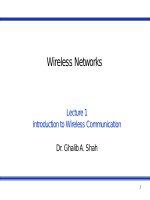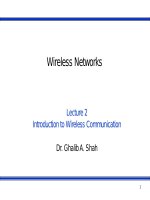Wireless networks - Lecture 27: WLAN
Bạn đang xem bản rút gọn của tài liệu. Xem và tải ngay bản đầy đủ của tài liệu tại đây (382.89 KB, 23 trang )
Wireless Networks
Lecture 27
WLAN Part II
Dr. Ghalib A. Shah
1
Outlines
Last Lecture Review
Problems with DCF
Virtual Carrier Sensing
RTC/CTS Protocol
Interframe Spacing
PCF
Fragmentation / Reassembly
MAC Frame Format
Frame Types
Physical Media in Original IEEE 802.11
2
Last Lecture
Overview of IEEE 802.11
IEEE 802.11 Protocols
Architecture
Services
MAC Protocols
► DCF
► PCF
3
Problems with DCF
Hidden Node
A
B
C
4
Exposed Node problem
A
B
C
D
5
RTS/CTS Protocol
Virtual Carrier Sense
technique.
Source sends Request-toSend beacon
Destination, if free, sends
Clear-to-Send beacon.
Source transmits data packet.
Destination ACKs if receives
successfully
RTS
CTS
MDU
ACK
Destination
Source
6
RTS includes source, destination ID and duration of following
transaction.
The duration info allows to protect the transmission from collision
on the transmitter side.
The destination response in CTS also includes the same duration
amount.
This helps in overcoming hidden terminal problem.
All the stations hearing RTS/CTS set their Network Allocation
Vector (NAV) to the given duration.
Since RTS/CTS are shorter frames than MSDU, collision is
detected fast.
If MSDU is smaller than RTSThreshold, Standard allows to skip
RTS/CTS.
7
Interframe Spacing
Short interframe space (SIFS)
► The SIFS is used for the highest-priority transmissions, such as
RTS/CTS frames and positive acknowledgments.
PCF interframe space (PIFS)
► The PIFS is used by the PCF during contention-free operation.
Stations with data to transmit in the contention-free period can
transmit after the PIFS has elapsed and pre-empt any
contention-based traffic
DCF interframe space (DIFS)
► The DIFS is the minimum medium idle time for contentionbased services. Stations may have immediate access to the
medium if it has been free for a period longer than the DIFS.
Extended interframe space (EIFS)
► The EIFS is not a fixed interval. It is used only when there is an
error in frame transmission.
8
SIFS
DIFS
Sender
MPDU
RTS
SIFS DIFS
SIFS
Receiver
Other
CTS
ACK
CW
Next MPDU
NAV(RTS)
NAV(CTS)
Backoff after defer
Defer Access
9
Point Coordination Function
Centralized access to medium.
Implemented on top of DCF.
AP issues polls to the MS on round robin
fashion.
PIFS is used between polling.
10
11
Fragmentation and Reassembly
In Ethernet, MAC frame can be upto 1518 bytes long.
Not possible to support such larger size of frame
because of:
► Higher bit error rate
► If it is corrupted, large size would incur high overheads.
► On FH, medium is interrupted periodically (20ms), smaller
packet would result in smaller chance of postponing
transmission.
12
In IEEE 802.11 segmentation/reassembly is
added to support Ethernet frames.
Each MSDU is divided into several
frames/segments.
All the segments are transmitted after SIFS of
ACK reception.
Segments are reassembled to MSDU in the
order as transmitted.
13
MAC Frame Format
14
MAC Frame Fields
Frame Control – frame type, control information
Duration/connection ID – channel allocation time
Addresses – context dependant, types include source and
destination
Sequence control – numbering and reassembly
Frame body – MSDU or fragment of MSDU
Frame check sequence – 32bit CRC
15
Addresses
De s tination addre s s
► As in Ethernet, the destination address is the 48-bit IEEE MAC
identifier that corresponds to the final recipient: the station that
will hand the frame to higher protocol layers for processing.
S ource addre s s
► This is the 48-bit IEEE MAC identifier that identifies the source
of the transmission. Only one station can be the source of a
frame, so the Individual/Group bit is always 0 to indicate an
individual station.
R e ce ive r addre s s
► This is a 48-bit IEEE MAC identifier that indicates which
wireless station should process the frame. If it is a wireless
station, the receiver address is the destination address.
Trans m itte r addre s s
► This is a 48-bit IEEE MAC address to identify the wireless
interface that transmitted the frame onto the wireless medium.
16
Frame Control Fields
Protocol version – 802.11 version
Type – control, management, or data
Subtype – identifies function of frame
To DS – 1 if destined for DS
From DS – 1 if leaving DS
More fragments – 1 if fragments follow
Retry – 1 if retransmission of previous frame
Power management – 1 if transmitting station is in sleep
mode
More data – Indicates that station has more data to send
WEP – 1 if wired equivalent protocol is implemented
Order – 1 if any data frame is sent using the Strictly Ordered
service
17
Control Frame Subtypes (Type 01)
Power save – poll (PSPoll)
Request to send (RTS)
Clear to send (CTS)
Acknowledgment
Contentionfree (CF)end
CFend + CFack
18
Data Frame Subtypes (Type 10)
Datacarrying frames
►
►
►
►
Data
Data + CFAck
Data + CFPoll
Data + CFAck + CFPoll
Other subtypes (don’t carry user data)
►
►
►
►
Null Function
CFAck
CFPoll
CFAck + CFPoll
19
Management Frame Subtypes (Type 00)
Association request
Association response
Reassociation request
Reassociation response
Probe request
Probe response
Beacon
Announcement traffic indication message
Dissociation
Authentication
Deauthentication
20
Physical Media Defined by Original 802.11
Standard
Directsequence spread spectrum
► Operating in 2.4 GHz ISM band
► Data rates of 1 and 2 Mbps
Frequencyhopping spread spectrum
► Operating in 2.4 GHz ISM band
► Data rates of 1 and 2 Mbps
Infrared
► 1 and 2 Mbps
► Wavelength between 850 and 950 nm
21
IEEE 802.11a and IEEE 802.11b
IEEE 802.11a
►
►
►
►
Makes use of 5GHz band
Provides rates of 6, 9 , 12, 18, 24, 36, 48, 54 Mbps
Uses orthogonal frequency division multiplexing (OFDM)
Subcarrier modulated using BPSK, QPSK, 16QAM or 64QAM
IEEE 802.11b
► Provides data rates of 5.5 and 11 Mbps
► Complementary code keying (CCK) modulation scheme
22
Summary
Problems with DCF
Virtual Carrier Sensing
RTC/CTS Protocol
Interframe Spacing
PCF
Fragmentation / Reassembly
MAC Frame Format
Frame Types
Physical Media in Original IEEE 802.11
23









